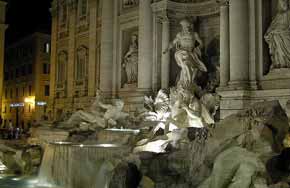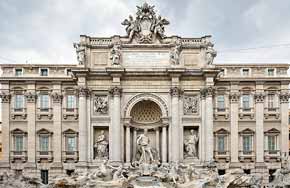The Trevi Fountain is a mesmerizing fountain placed in the Trevi district in Rome, Italy. Standing at the height of 26 meters, the Trevi Fountain is 20 meters wide. The fountain is the biggest fountain in Trevi and one of the most distinguished fountains, all over the world. Housed at the joining point of three famed roads, the fountain denotes the terminal phase of the “modern” Acqua Vergine, the relived Aqua Virgo, which is one of the historical aqueducts that used to provide water to ancient Rome. The scene presented on the Trevi Fountain is said to be taken from 19 BC, where Roman technicians founded a source of pure water, some 13 km away from Trevi, with the help of a virgin.
Further, the ultimate indirect path of the aqueduct is 22 km in length, which is about 14 mi. This Aqua Virgo allows the water to fall into the Baths of Agrippa, a Roman statesman and general. It helped Rome for more than four Centuries. The coup de grâce for the city life of late classical Rome came into practiced when the Goth besiegers in 537/38 destroyed the aqueducts. Coup de grâce signifies a death blow aimed to finish the suffering of an injured creature without the will of the sufferer. Medieval Romans were reduced to getting water from contaminated wells as well as the Tiber River, which was also utilized as a sewer.
The Roman tradition of constructing a handsome fountain
at the termination of an aqueduct that fetched water
to Rome was again started in the 15th century, with the
Renaissance, a famous cultural movement of the Late Middle
Ages. In 1453, Pope Nicholas V completed repairing the
Acqua Vergine aqueduct and constructed a simple basin,
designed by Leon Battista Alberti, the famous humanist
architect, to herald the advent of the water. Additionally,
the Trevi Fountain was finally completed in the year
1762 by Giuseppe Pannini, who replaced the current allegories
for designed sculptures of Agrippa & “Trivia”,
the Roman virgin. The Trevi fountain was renovated in
the year 1998; the stonework was called off and the fountain
was added with re-circulating pumps.
Additionally, a customary fable holds that if travelers
throw a coin into the waters of Trevi fountain, then
they have successfully insured their return to Rome.
According to the estimation, about 3000 Euros are thrown
into the Trevi fountain, every day. The money collected
from the fountain is used to help the needy people of
Rome.







